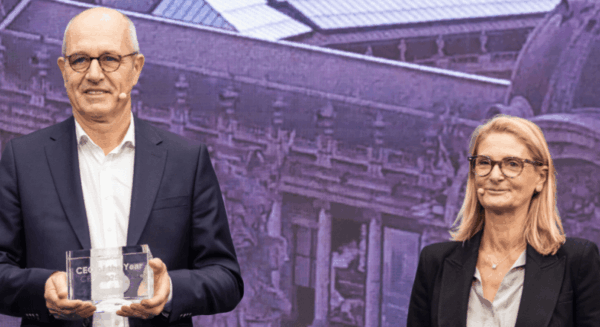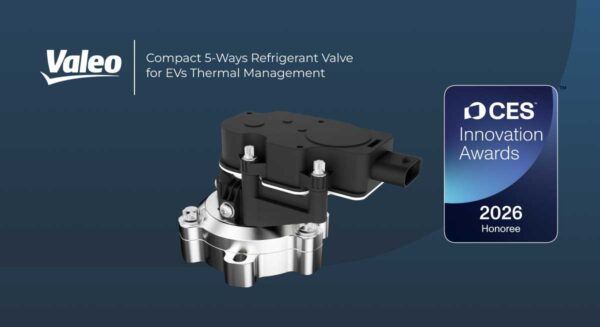Valeo Group | Nov 25, 2025 | 2 min
Valeo’s kit for reducing industrial energy consumption
Meet our engineers who have developed a mobile kit that calculates the energy consumption of industrial sites in real time and, thanks to AI, suggests levers for reducing consumption by up to 20%.
Baptiste Brasset, Valeo Power division data and energy project Leader, is behind this mobile energy consumption reduction case, for which he won an “engineer of the future” trophy organized by l’Usine Nouvelle. Ahmed Ait Hadj Iaich, AI team project Leader at Valeo Power, developed the AI platform used to identify levers for improving energy consumption, based on data collected by the suitcase. We met these two passionate engineers.
Can we come back to the origin of this innovation? How did you come up with the concept and when?
Baptiste Brasset: “It all started in 2021. I was an apprentice at the time and my boss – Eric Manouvrier who is Industrial Digitalization Director & Master process expert in data – asked me to work on what was at the time the first project that explored the use of big data to reduce energy consumption within Valeo. It was the MaGIC project for Manufacturing General Intelligent Consumption. The aim was to use big data to reduce energy consumption by around 5% on a production line at our Abbeville site in northern France. So we installed sensors at each workstation on the production line. At each workstation, operators could see energy consumption in real time. That’s how we identified the first levers for improvement. And then we realized that, paradoxically, most of these levers lay not in the moments when the line was running, but when it was stopped. Because the machines were designed to run 24/7. Even if the machines were in eco mode when the line was stopped, this was not at all optimized. And depending on how the line was stopped, we had very different consumption thresholds. We therefore decided that the lowest consumption threshold should become the norm on a daily basis.“
So what were the first actions taken?
Baptiste Brasset: “The first action was to automate stoppages. It’s not the line operators and conductors who are going to stop their production lines, stop the machines, and so on. From the moment the operator decided to stop the line, everything had to be stopped automatically, so that we could be sure of reaching that famous standard, the minimum consumption. We have automated the shutdown of furnaces, refrigeration units and ventilation systems… And just by doing this, we achieved savings of up to 15%. The project was a success. But now, of course, we wanted to take it a step further and roll it out on a much larger scale.”
And that’s how the idea of the mobile kit was born…
Baptiste Brasset: “Exactly! And that’s because to scale up, we could not afford to buy sensors for all the production lines of all the factories. It would have been way too expensive. That’s how we came up with the idea of the mobile suitcase that can be easily transported, easily connected from one line to another, and with no impact on production. A first homemade prototype has been developed by our team in Valeo Abbeville and that’s when we started working with Schneider Electric and Prosyst, a Schneider subsidiary that the first industrial prototype came out. Schneider Electric brought its wireless sensors to the project, allowing us to connect even more simply from one line to another. And Prosyst contributed a software which enables us to retrieve data from all kinds of sources – PLCs, the beacon, a computer, a robot, a machine – and display it in a simple, immediately readable way.”
And this suitcase is AI-powered, we can say, thanks to a home-made application developed by you, Ahmed.
Ahmed Ait Hadj Iaich: “Yes, because the system makes it possible to collect a huge amount of data, but for this to be useful, we need to be able to interpret it intelligently in minimum time, and make it understandable for as many people as possible. This is where AI comes in. That’s why we’ve developed a no-code AI platform that basically lets you do the work of a data scientist, without having to code.The platform enables data preprocessing, advanced and interactive visualizations, and the application of various AI models to explore the data at a deeper level. It helps uncover key insights and extract important features that can contribute to improving energy efficiency, and presents it all in a simple, straightforward and intelligible way. Without this application, the work would take days and days. And thanks to the application, anyone can use this case without being an expert in AI or data processing.”
Where do we stand today in terms of observed benefits?
Ahmed Ait Hadj Iaich: “The first test with the AI-powered suitcase was carried out over the summer at our San Luis Potosi plant in Mexico. Above all, we were looking for quick-savings, knowing that logically, beyond what we can immediately gain, we know that over the long term we can identify complementary levers, which is perhaps even more important. We were on the production line with an expert who knew the line perfectly, the processes and the way things worked, which is absolutely essential for doing a good job. And after just one week’s work: we managed to reduce the line’s consumption by around 20%! Just imagine the potential!”
What are the next steps and objectives now?
Baptiste Brasset: “The goal, of course, is large-scale deployment at Valeo sites. We already have six suitcases for the different regions of the world where we operate: Europe, America, Asia… The suitcase will thus support the Group’s objectives in terms of reducing CO2 emissions. We also decided to propose the concept to other interested industrial players beyond Valeo. And we know that reducing energy consumption is a key issue for companies today, from small companies to international groups.”



